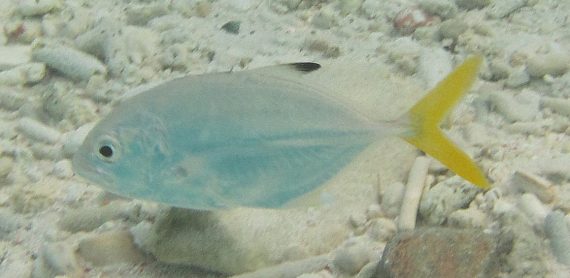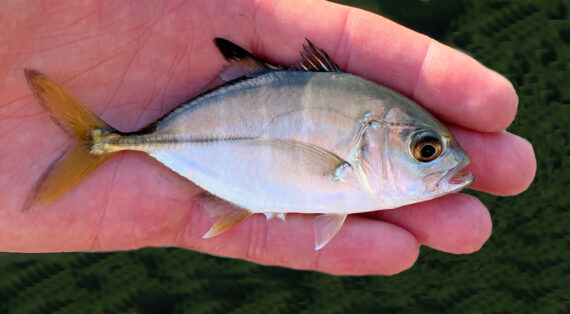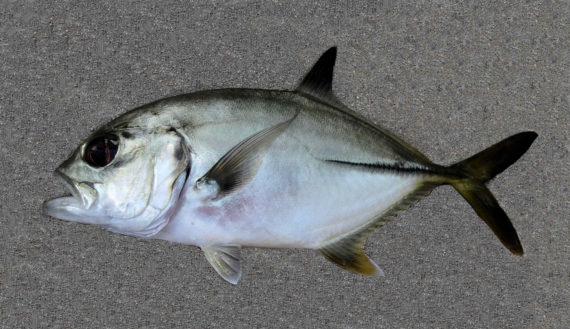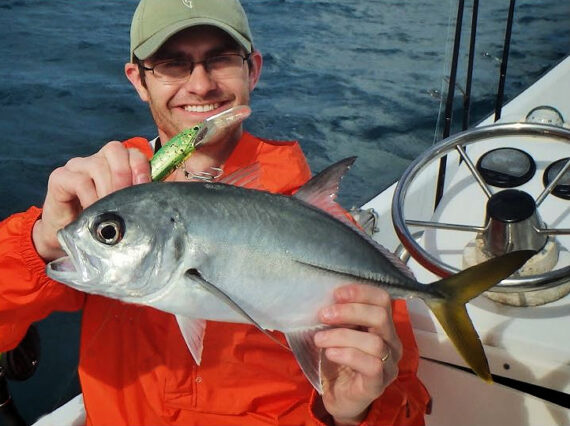Horse-eye Jack, Caranx latus
 Horse-eye Jack, Caranx latus, Juvenile. Underwater photograph taken in coastal waters of Bonaire, December 2019. Photograph and identification courtesy of Bob Hillis, Ivins, Utah.
Horse-eye Jack, Caranx latus, Juvenile. Underwater photograph taken in coastal waters of Bonaire, December 2019. Photograph and identification courtesy of Bob Hillis, Ivins, Utah.
 Horse-eye Jack, Caranx latus, Juvenile. Fish caught from coastal waters off Lauderdale-by-the-Sea, Florida, July 2020. Length: 10.5 cm (4.1 inches). Catch, photograph and identification courtesy of Luke Ovgard, Klamath Falls, Oregon.
Horse-eye Jack, Caranx latus, Juvenile. Fish caught from coastal waters off Lauderdale-by-the-Sea, Florida, July 2020. Length: 10.5 cm (4.1 inches). Catch, photograph and identification courtesy of Luke Ovgard, Klamath Falls, Oregon.
 Horse-eye Jack, Caranx latus. Fish caught in coastal waters off Key Largo, Florida, December 2014. Length: 37 cm (15 inches). Catch, photograph and identification courtesy of Ben Cantrell, Peoria, Illinois.
Horse-eye Jack, Caranx latus. Fish caught in coastal waters off Key Largo, Florida, December 2014. Length: 37 cm (15 inches). Catch, photograph and identification courtesy of Ben Cantrell, Peoria, Illinois.
 Horse-eye Jack, Caranx latus. Fish caught from coastal waters off Key Largo, Florida, January 2014. Length: 50 cm (20 inches). Catch, photograph, and identification courtesy of Josh Leisen (joshadventures.com), Gaylord, Michigan.
Horse-eye Jack, Caranx latus. Fish caught from coastal waters off Key Largo, Florida, January 2014. Length: 50 cm (20 inches). Catch, photograph, and identification courtesy of Josh Leisen (joshadventures.com), Gaylord, Michigan.
 Horse-eye Jack, Caranx latus. Fish caught in coastal waters off Key Largo, Florida, February 2015. Length: 52 cm (20 inches). Catch, photograph and identification courtesy of Dean Kimberly, Atlanta, Georgia.
Horse-eye Jack, Caranx latus. Fish caught in coastal waters off Key Largo, Florida, February 2015. Length: 52 cm (20 inches). Catch, photograph and identification courtesy of Dean Kimberly, Atlanta, Georgia.
 Horse-eye Jack, Caranx latus. Fish caught off the beach of Playa de Carmen, Riviera Maya, Quintana Roo, April 2012. Length: 88 cm (2 feet 11 inches). Weight: 12 kg (26 lbs). Catch and photograph courtesy of Maurice Kerger, Holland.
Horse-eye Jack, Caranx latus. Fish caught off the beach of Playa de Carmen, Riviera Maya, Quintana Roo, April 2012. Length: 88 cm (2 feet 11 inches). Weight: 12 kg (26 lbs). Catch and photograph courtesy of Maurice Kerger, Holland.
The Horse-eye Jack, Caranx latus, is a common member of the Jack or Carangidae Family, that is known in Mexico as jurel blanco. Globally, there are seventeen species in the genus Caranx, of which nine are found in Mexican waters, three in the Atlantic and five in the Pacific and one in both the Atlantic and Pacific Oceans.
The Horse-eye Jack has a moderately compressed deep oblong body with a depth that is 29% to 33% of standard length. They are dark blue to blue-gray dorsally and silvery-white to golden ventrally. Their caudal fin is yellow and their dorsal fin and upper portion of their caudal fin have dark tips. They have prominent black scutes along their caudal fin base. Juveniles have broad black bars along their sides. They have a rounded head, a blunt snout, disproportionately large eyes (after which they are named), and a large mouth that extends past the eyes and opens at the front. Their pectoral fins are pointed. They have 22 to 25 gill rakers and 32 to 39 scutes. Their lateral line is strong with a moderately long anterior arch. Their body is covered with small scales.
The Horse-eye Jack is a pelagic subtropical schooling fish, with adults usually found in offshore rocky reefs at depths up to 420 feet and juveniles found in large schools along shores of sandy beach, over muddy bottoms, and in brackish rivers. They reach a maximum length of 1.10 m (3 feet 7 inches). As of January 1, 2024, the International Game Fish Association world record for length stood at 77 cm (2 feet 6 inches) with the fish caught from coastal waters off Bimini, Bahamas in June 2011 The corresponding world record for weight stood at 14.51 kg (32 lbs 0 oz) with the fish caught from coastal waters off in the Gulf of Mexico off Texas in September 2012. They are opportunistic predators feeding on benthic and pelagic fish as well as squid and crustaceans.
The Horse-eye Jack is a resident of all Mexican waters of the Atlantic Ocean including the Gulf of Mexico and the east coast of the Yucatán Peninsula in the Caribbean.
The Horse-eye Jack can be confused with the Crevalle Jack, Caranx hippos (prominent black spot on pectoral fin base).
From a conservation perspective the Horse-eye Jack is currently considered to be Highly Vulnerable and subject to EXTINCTION due to heavy fishing pressure. They are a very popular game fish for recreational anglers. They are also fished commercially via purse seines and traps. They are sold commercially on a limited basis, although their food value is viewed as marginal and larger fish are known to contain ciguatoxin.